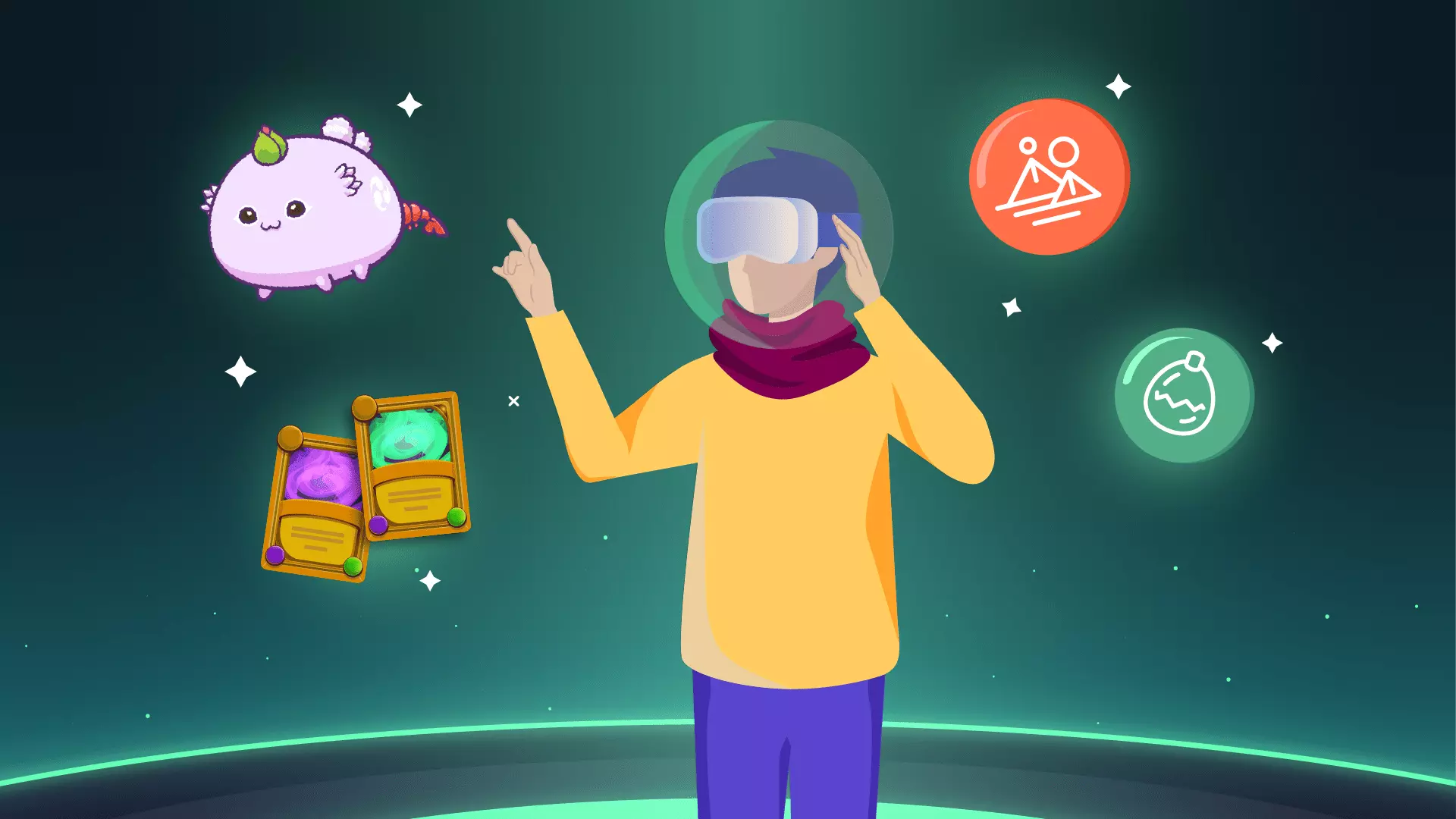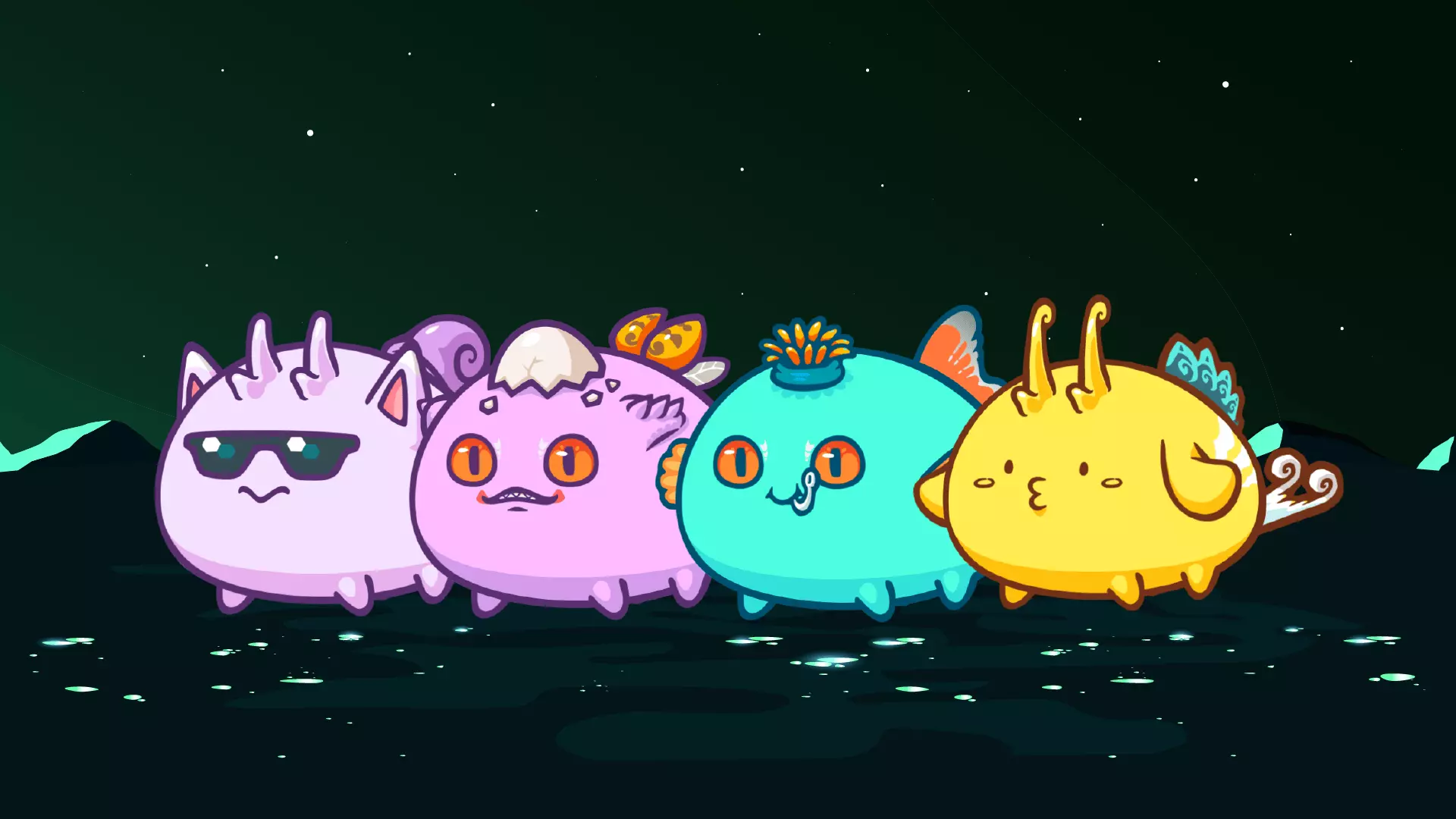The play-to-earn philosophy. Tokens as a form of reward for players. NFTs and security over the ownership of characters, items and land.

Tokens are a crucial part of this model. Fungibles are used for reward payments. For example, in Axie Infinity, with each triumph a number of Smooth Love Potions (SLP) are collected, represented by fungible tokens with economic value. While NFTs can appear as characters, as avatars and also in the form of land: unique digital plots that can be built on, for example.

Play-to-earn games use NFTs to grant players ownership of their characters, items, and terrain.
The #WAGMI philosophy: we all play the game
This system is much fairer and more compensated for players. The thing is that although the development team of a game is essential, so is its community: the players are the ones who, with their time, their effort, their study and their creativity, manage to give true life to the games. The play-to-earn model seeks to be fairer with them.
In this type of game you can perform actions and missions in exchange for prizes, represented by a fungible token such as SLP. Additionally, Axie Infinity also distributes its AXS governance token to the top 1,000 players each season.
These avatars, collectibles and items that the player earns are not only added to his in-game inventory, but they have an economic value and are integrated into his portfolio of crypto assets, since they are his property. That ownership is settled on the blockchain, so it becomes unalterable except for the owner, who can sell, lend, rent and do many other things with their NFTs.
The Axie Infinity case
What Axie Infinity is about. Unique characters with a “family tree” thanks to NFT technology. How to create new NFTs from the main blockchain game.

One of the main and most massive blockchain games was created in 2018 by Vietnamese developer Sky Mavis. Axie Infinity consists of acquiring, raising, and fighting creatures known as axies. Players can assemble teams with three axies to fight against each other or against the game’s artificial intelligence. In both cases, winning earns an amount of the SLP fungible token.
But the most interesting thing is that these axies are also NFTs. Each creature is unique, it has certain parts of its body that enable it to launch powers specific to those parts, and it also has the ability to reproduce. By having two axies, an AXS governance token, and an amount of SLP, players can create a new axie from crossing two original ones.
Every character in the game was raised or bred by someone. They have their own blockchain identifier and a kind of “family tree” that determines their “DNA”. In this case, the type of parts it can have, and therefore its characteristics (strength, stamina, morale, speed) and the kind of powers it can use in battles.

Axie Infinity is the main blockchain game of the moment, with a gigantic community and a fun proposal.
AXS, SLP and the NFT mint in Axie Infinity
AXS and SLP are ERC-20 fungible tokens, which operate on the Ethereum network and are the basis of the Axie Infinity economy. They are obtained as a reward in the game, but they can also be purchased in Ripio.
Both tokens are necessary to mint Axie Infinity NFTs: that is, to create new axies from the crossing of two pre-existing NFT creatures in your portfolio.
AXS, or Axie Infinity Shard, is the staking and governance token of Axie Infinity. Mainly, it serves to create new axies, but also to stake and earn interest, or to participate in decentralized decision making.
SLP, or Smooth Love Potion, is the utility token of the game, and is received as a reward for battles won and missions completed. In addition, you can also stake it or trade it on exchanges.
The Decentraland case
December 15, 2021
Online gaming as a prelude to the metaverse. Online experiences based on blockchain. The Centralland economy and the idea of ”digital parcels”.

Blockchain-based video games revolutionized the gaming world but not only because they established another economic model. Furthermore, NFT gaming implies a new step for online video games, and opens the door to the massiveness of the idea of the metaverse, a virtual social, creative and economic space that found a terrain to expand in blockchain.
One of the most obvious cases is Decentraland, a social virtual reality platform created on Ethereum. Decentraland is an open virtual world where you create avatars, interact with others, and complete tasks. A central part of the game is being able to buy plots (LAND) of that world and build on them. These digital lands are NFTs that are registered on the blockchain.
Decentraland is one of the largest metaverse experiences, where NFTs secure ownership over digital land.
MANA and LAND, the tokens of Decentraland
To advance in Decentraland you need MANA, the game’s fungible token, which you can also buy on Ripio and which also works as a governance token. With those MANA, in addition to making decisions within the Decentraland ecosystem, you can access to buy a digital plot or LAND, the main NFT of Decentraland. Each LAND uniquely identifies a Decentraland user’s ownership of their land. This NFT is both your lot in the metaverse, but also “the deed” to that land.
Your plot in the metaverse
The metaverse is a persistent digital environment. A virtualization that visually can lead us to think about the online worlds of video games. The metaverse is only one, but it can contain various experiences, different “maps” or proposals, in a digital world much larger than that of any known video game, and with no limit on participants.
This virtual 3D and online space allows you to replace or complement many aspects of life using an avatar. For the common user, the metaverse can be “walked” at will, controlling our character to interact, trade, work, solve problems or have fun. Whatever we want. Except that all of this happens in a more live environment, inspired by multiplayer video games and social networks, and that also works in a decentralized way, like blockchain networks.
Trends in NFT games
Most popular types of games in NFT gaming. Different uses of NFT for video games. Panorama of competitive, farming and metaverse NFT video games.

Gods Unchained was one of the first NFT video games to be successful and become a benchmark. It is a game of collectible digital cards representing creatures and spells with which players can fight others. It is a system similar to that of TCG games such as Magic: the Gathering, Pokémon or Yu-Gi-Oh!, or digital examples such as Heartstone. This system of characters with powers represented by NFTs is also the core of games like Axie Infinity or Splinterlands, some of the most established in the environment.
Another current trend is marked by games such as CryptoMines, CryptoCars or MetaSoccer, where different teams (of space miners, racing cars or soccer players, depending on the case) are assembled to repeat a mission once a day in exchange for a reward in crypto. : a space mission, a race, a match. These events are resolved based on an automated crossing of statistics, which takes into account the powers and abilities of each character in addition to a luck or random factor.
Another increasingly thriving line is the one that is inspired by video games from online worlds such as Fortnite or Minecraft to present its metaverse experiences: these are the cases of Decentraland, The Sandbox, Bloktopia or Upland. In these examples, the “success” of the player is not determined by the result they obtain while playing or by the statistical effectiveness of their team of characters, but by the ability to get involved in the community and grow with it.
There are many other examples of NFT gaming, and of course a lot of cases come from successful formats in traditional video games. Like Lost Relics, a dungeon-raiding RPG, complete with goblins, chests, and magical swords. Or like Plant vs Undead, whose reference is more than obvious.

